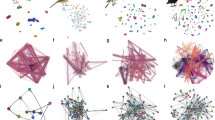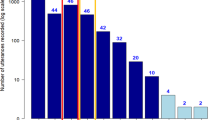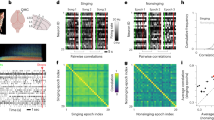Abstract
Human vocalization systems are characterized by complex structural properties. They are combinatorial, based on the systematic reuse of phonemes, and the set of repertoires in human languages is characterized by both strong statistical regularities—universals—and a great diversity. Besides, they are conventional codes culturally shared in each community of speakers. What are the origins of the forms of speech? What are the mechanisms that permitted their evolution in the course of phylogenesis and cultural evolution? How can a shared speech code be formed in a community of individuals? This chapter focuses on the way the concept of self-organization, and its interaction with natural selection, can throw light on these three questions. In particular, a computational model is presented which shows that a basic neural equipment for adaptive holistic vocal imitation, coupling directly motor and perceptual representations in the brain, can generate spontaneously shared combinatorial systems of vocalizations in a society of babbling individuals. Furthermore, we show how morphological and physiological innate constraints can interact with these self-organized mechanisms to account for both the formation of statistical regularities and diversity in vocalization systems.
Access this chapter
Tax calculation will be finalised at checkout
Purchases are for personal use only
Similar content being viewed by others
Notes
- 1.
We only give here a general description of the system: a detailed mathematical description is available in (Oudeyer 2006).
- 2.
Connections between the two maps evolve according to Hebb’s law: those that link neurons that are often activated in a correlated manner are reinforced, whereas those that link neurons with uncorrelated activation become weaker. These connections are initially random, and through babbling and Hebb’s law, they self-organize and finally allow the robot to find motor commands that correspond to a given sound that he perceives.
- 3.
Neurons adapt to stimuli through sensitization: their dynamics is such that if a stimulus S is perceived, then they are modified such that if the same stimulus S would be presented just afterwards they would be more activated than the first time, and the amount of modification depends exponentially on their activation (strongly activated neurons are modified most).
- 4.
- 5.
This term was introduced in (Gould and Vrba 1982). It refers to the use of a biological feature/structure for a function A which is different than the function B for which it was initially evolutionary selected.
References
Ashby, W.R.: An Introduction to Cybernetics. Chapman & Hall, London (1956)
Bak, P.: How Nature Works: The Science of Self-Organized Criticality. Copernicus, New York (1996)
Ball, P.: The Self-Made Tapestry : Pattern Formation in Nature. Oxford University Press, Oxford (2001)
Batali, J.: Computational simulations of the emergence of grammar. In: Hurford, J.R., Studdert-Kennedy, M., Knight, C. (eds.) Approaches to the Evolution of Language: Social and Cognitive Bases. Cambridge University Press, Cambridge (1998)
Berrah, A., Glotin, H., Laboissière, R., Bessière, P., Boë, L.J.: From form to formation of phonetic structures: an evolutionary computing perspective. In: 13th International Conference on Evolutionary Computing and Machine Learning (ICML), pp 23–29. MIT Press, Bari (1996)
Bonabeau, E., Theraulaz, G., Deneubourg, J.L., Aron, S., Camazine, S.: Self-organization in social insects. Trends in Ecology and Evolution 12, 188–193 (1997)
Brenowitz, E.A., Beecher, M.D.: Song learning in birds : diversity and plasticity, opportunities and challenges. Trends in Neuroscience 28(3), 127–132 (2005)
Camazine, S., Deneubourg, J.-L., Franks, N.R., Sneyd, J., Theraulaz, G., Bonabeau, E.: Self-Organization in Biological Systems. Princeton University Press, Princeton (2002)
Dawkins, R.: The Blind Watchmaker. W. W. Norton and Company, New York (1986)
de Boer, B.: The Origins of Vowel Systems. Oxford University Press, Oxford Linguistics, Oxford (2001)
Elredge, N., Gould, S.J.: Punctuated equilibria : an alternative to phylogenetic gradualism. In: Schopf, T.J.M. (ed.) Models in Paleobiology, pp. 82–115. Freeman, San Francisco (1972)
Gould, S.J., Vrba, E.S.: Exaptation: a missing term in the science of form. Paleobiology 8(1), 4–15 (1982)
Hauser, M.D.: The Evolution of Communication. MIT Press, BradfordBooks, Cambridge (1997)
Kauffman, S.: At Home in the Universe : The Search for Laws of Self-Organization and Complexity. Oxford University Press, Oxford (1996)
Keefe, A., Szostak, J.: Functional proteins from a random sequence library. Nature 410, 715–718 (2001)
Kaplan, F.: La naissance d’ une langue chez les robots. Hermès (2001)
Kaplan, F., Oudeyer, P.-Y., Bergen, B.: Computational models in the debate over language learnability. Infant Child Dev. 17(1), 55–80 (2008)
Kirby, S.: Spontaneous evolution of linguistic structure: an iterated learning model of the emergence of regularity and irregularity. IEEE Trans. Evol. Comput. 5(2), 102–110 (2001)
Kohonen, T.: The neural phonetic typewriter. Computer 21(3), 11–22 (1988)
Liljencrantz, J., Lindblom, B.: Numerical simulation of vowel quality systems: the role of perceptual contrast. Language 48, 839–862 (1972)
Maddieson, I.: Patterns of Sounds. Cambridge University Press, Cambridge (1984)
Mrayati, M., Carre, R., Guerin, B.: Distinctive regions and modes: a new theory of speech production. Speech Commun. 7, 257–286 (1988)
Nicolis, G., Prigogine, I.: Self-Organization in Non-equilibrium Systems: From Dissipative Structures to Order Through Fluctuations. Wiley, New York (1977)
Oudeyer, P.-Y.: Origins and learnability of syllable systems, a cultural evolutionary model. In: Collet, P., Fonlupt, C., Hao, J., Lutton, E., Schoenauer, M. (eds.) Artificial Evolution; LNCS 2310, pp. 143–155 (2001)
Oudeyer, P.-Y.: The self-organization of speech sounds. J. Theor.l Biol. 233(3), 435–449 (2005a)
Oudeyer, P.-Y.: The self-organization of combinatoriality and phonotactics in vocalization systems. Connection Sci. 17(3–4), 325–341 (2005b)
Oudeyer, P-Y.: Self-Organization in the Evolution of Speech. Oxford University Press, Oxford (2006)
Oudeyer, P.-Y., Kaplan, F.: Language evolution as a darwinian process: computational studies. Cogn. Process. 8(1), 21–35 (2007)
Pierrehumbert, J.: Exemplar dynamics: word frequency, lenition, and contrast. In: Bybee, J., Hopper, P. (eds.) Frequency Effects and the Emergence of Linguistic Structure. John Benjamins, Amsterdam (2001)
Pfeifer, R., Scheier, C.: Understanding Intelligence. MIT Press, Cambridge (1999)
Sanguineti, V., Laboissière, R., Ostry, D.J.: A dynamic biomechanical model for neural control of speech production. J. Acoust. Soc. Am. 103(3), 1615–1627 (1998)
Snowdown, C.T., Hausberger, M.: Social Influences on Vocal Development. Cambridge University Press, Cambridge (1997)
Steels, L.: The synthetic modeling of language origins. Evolution of communication, 1(1), 1-34 (1997).
Steels, L.: The methodology of the artificial. Behav. Brain Sci. 24(6), 1077–1078 (2001)
Steels, L.: The emergence and evolution of linguistic structure: from lexical to grammatical communication systems. Connection Sci. 17(3–4), 213–230 (2005)
Stevens, K.N.: On the quantal nature of speech. J. Phonetics 17, 3–45 (1989)
Studdert-Kennedy, M., Goldstein, L.: Launching language: the gestural origin of discrete infinity. In: Christiansen, M., Kirby, S. (eds.) Language Evolution: The State of the Art, pp. 235–254. Oxford University Press, Oxford (2003)
Tritton, D.J.: Physical Fluid Dynamics. Oxford University Press, Oxford (1988)
Tyack, P.: Interactions between singing hawaian humpback whales and conspecifics nearby. Behav. Ecol. sociobiol. 8(2), 105–116 (1981)
Vichniac, G., Manneville, P., Boccara, N., Bidaux, R. (eds.): Cellular automata and modeling of complex systems. In: Workshop Les Houches. Springer, Heidelberg (1989)
Vihman, M.: Phonological Development: The Origins of Language in the Child. Blackwell, Cambridge (1996)
Waldrop, M.: Spontaneous order, evolution, and life. Science 247, 1543–1545 (1990)
Wedel, A.: Exemplar models, evolution and language change. Linguist. Rev. 23, 247–274 (2006)
Weisbuch, G.: Complex systems dynamics. Addison-Wesley, Redwood City, CA (1991)
Acknowledgments
This work was in major part achieved in the Sony Computer Science Laboratory, Paris, and benefited from the support of Luc Steels.
Author information
Authors and Affiliations
Corresponding author
Editor information
Editors and Affiliations
Rights and permissions
Copyright information
© 2013 Springer-Verlag Berlin Heidelberg
About this chapter
Cite this chapter
Oudeyer, PY. (2013). Self-Organization: Complex Dynamical Systems in the Evolution of Speech. In: Binder, PM., Smith, K. (eds) The Language Phenomenon. The Frontiers Collection. Springer, Berlin, Heidelberg. https://doi.org/10.1007/978-3-642-36086-2_9
Download citation
DOI: https://doi.org/10.1007/978-3-642-36086-2_9
Published:
Publisher Name: Springer, Berlin, Heidelberg
Print ISBN: 978-3-642-36085-5
Online ISBN: 978-3-642-36086-2
eBook Packages: Physics and AstronomyPhysics and Astronomy (R0)





